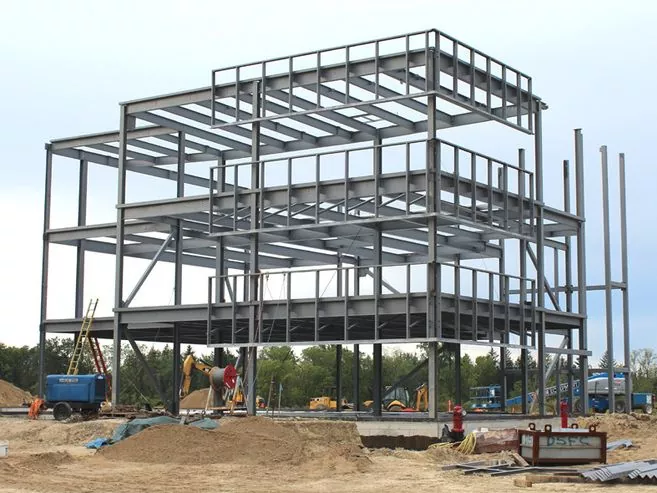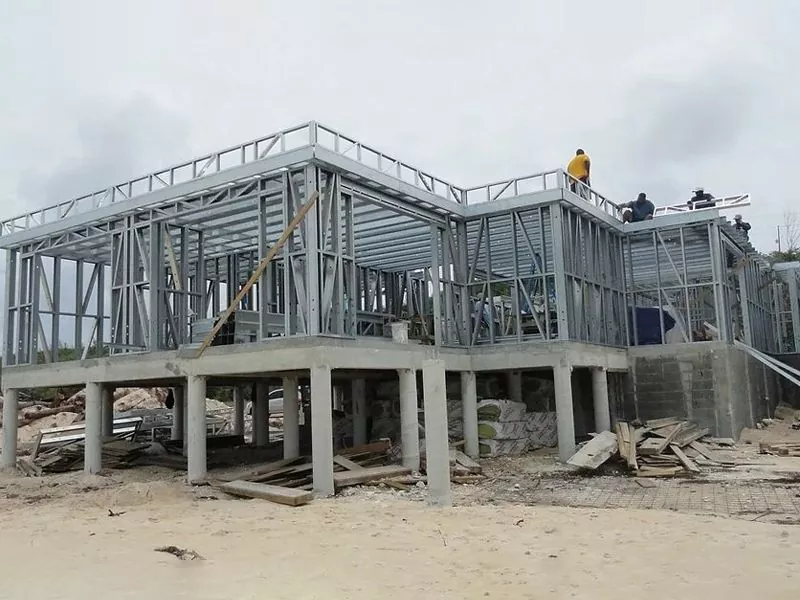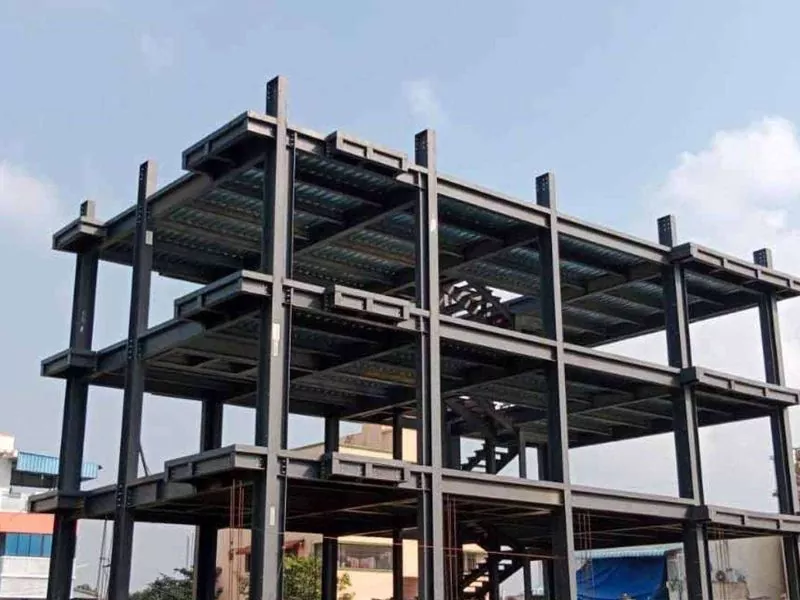QR Code

EIHE steel structure’s steel frame residential buildings are constructed using a steel framework as the primary structural support. This type of construction offers several advantages.
Firstly, steel has a high strength-to-weight ratio, which means it can support large loads while remaining lightweight. This reduces the overall weight of the building, leading to cost savings in foundation construction. Additionally, steel is a flexible material, making steel frame buildings excellent at resisting earthquakes and other natural disasters.
Secondly, steel frame residential buildings offer great flexibility in design. The steel framework can be easily modified to accommodate different floor plans and layouts, making it suitable for a wide range of residential needs.
Moreover, steel frame construction is highly industrialized. Steel components can be prefabricated in factories and then transported to the site for installation, significantly reducing on-site construction time and improving efficiency. This also results in less waste and environmental impact compared to traditional construction methods.
However, it's worth noting that steel frame construction also has some drawbacks. Steel is more expensive than traditional building materials like concrete, leading to higher initial costs. Additionally, steel is susceptible to corrosion, especially in damp or coastal environments, requiring regular maintenance and protection.
Overall, steel frame residential buildings offer a durable, flexible, and efficient construction method that can meet a wide range of residential needs. However, the initial cost and maintenance requirements should be carefully considered before deciding to use steel frame construction for a residential project.
1. What are the benefits of building a house with a steel frame?
1)Strength and Durability: Steel is incredibly strong and durable, making it resistant to damage from environmental factors like wind, rain, and snow. Additionally, steel is naturally resistant to fire, pests, and rot, making it an ideal choice for building materials.
2)Energy Efficiency: Steel-framed houses can be designed to be very energy-efficient, with insulation and ventilation systems that reduce heating and cooling costs.
3)Sustainability: Steel is a sustainable building material that is fully recyclable, meaning that it can be reused over and over again without losing its properties.
4)Versatility: Steel-framed houses can be designed to be very versatile, with large open spaces that can be configured in many different ways.
5)Speed of Construction: Steel-framed houses can be constructed faster than traditional homes because the steel components can be pre-fabricated and assembled on-site.
6)Reduced Maintenance: Steel-framed houses require less maintenance than homes built with other materials because they are resistant to many environmental factors and do not require regular treatments or coatings
2. Are steel frames more expensive than traditional wood frames?
The cost of building a house with a steel frame can vary depending on several factors such as the size of the house, complexity of design, local building codes, site location, and availability of materials and labor.
Generally speaking, steel frames can be more expensive initially compared to traditional wood frames, however there are some factors to consider when making the cost comparison. Firstly, steel frames are more durable, and are less prone to damage from weather, pests, and other hazards that can affect traditional wood-framed homes. This can lead to fewer repairs and replacements in the long run, which can reduce costs over time. Secondly, steel-framed homes have a longer lifespan than traditional wood-framed homes, which means that homeowners may not need to replace their home's framing as often.
Overall, when considering the initial costs versus the long-term savings and durability, steel frames can be a more cost-effective option for building a house compared to traditional wood frames. It is best to obtain cost estimates from qualified contractors and suppliers to get a more accurate idea of cost expectations for a specific project.
3. Is it possible to add extra insulation to a steel frame house?
Yes, it is possible to add extra insulation to a steel frame house. Steel-framed homes can be insulated to reduce heating and cooling costs, just like traditional wood-framed homes.
There are several types of insulation that can be used in steel-framed homes, including fiberglass batt insulation, rigid foam board insulation, and spray foam insulation. The specific type of insulation used will depend on the project's requirements and the desired energy efficiency goals.
Steel frame houses can also be designed to accommodate increased insulation after the initial construction, which is particularly useful in regions with extreme weather conditions. Insulation can be added to the attic, walls, and floors, which helps to reduce heat loss in the winter and heat gain in the summer, resulting in energy cost savings.
It's important to note that adding insulation to a steel frame house requires expertise in steel frame construction techniques. Therefore, it is best to consult with a professional contractor who has experience with steel frame construction to ensure that the insulation is properly installed and does not compromise the structural stability of the house.
4. Can steel frame houses be customized to fit specific design preferences?
Yes, steel frame houses can be customized to fit specific design preferences. Steel is a versatile construction material that allows for a wide range of designs and styles to be achieved. Steel frames can be configured to support various architectural styles, from contemporary to traditional, and steel-framed houses can incorporate a variety of building materials to achieve the desired look.
One advantage of steel frame construction is that it allows for large, open layouts that can be easily customized to fit specific design preferences. Steel frames can be erected to accommodate multi-story designs, large open living spaces, and finished basements, among other features. Additionally, steel-framed homes can have large windows that provide natural light and a sense of openness, which can be customized to fit the look of the house.
Architectural design software can also help to create custom designs and blueprints for steel-framed houses, allowing potential homeowners to see what their house will look like before construction begins.
5. Are steel frame houses more resistant to natural disasters than other types of homes?
Yes, steel frame houses are generally more resistant to natural disasters than other types of homes. Steel is an incredibly strong and durable construction material that is capable of withstanding extreme weather events such as high winds, hurricanes, tornadoes, and earthquakes.
Steel frame houses are engineered according to stringent building codes that require resistance to natural disaster events. For instance, in areas prone to hurricanes, steel frame houses can be designed to withstand high wind pressure and flying debris.
In areas prone to earthquakes, steel frame houses can be engineered to have seismic-resistant features such as reinforced steel columns and beams that can flex and withstand earthquakes.
Moreover, steel frame houses are resistant to rot, mold, and pest infestations, which can threaten the structural integrity of a house. Steel framing is also resistant to fire and has been found to have a higher fire rating compared to conventional building materials, reducing instances of major damages in case of a fire outbreak.
6. How do steel frame houses compare to traditional brick and mortar homes in terms of longevity?
Steel frame houses compare favorably to traditional brick and mortar homes in terms of longevity. Homeowners can expect a steel frame house to last decades, if not a century, or more before major repairs or replacement of the framing is required. In comparison to traditional brick-and-mortar homes, steel-framed homes have been found to require less maintenance due to their resistance to typical environmental factors that can cause damage to traditional wood-framed homes, such as rot, pests, and moisture.
The longevity of steel frame houses is due to many factors, such as the durability of steel as a building material and the fact that steel does not age in the same way that wood framing does. Moreover, steel frames are resistant to weather damage compared to wood frames, which can be affected by extreme weather events like hurricanes or high winds that can cause significant damage.
Steel frames are also immune to issues common in brick-and-mortar homes such as foundation cracks, brick corrosion, and mortar deterioration. Overall, steel frame houses are a durable, low maintenance, and long-lasting investment for homeowners.
7. Are there any precautions I should take before building a steel frame house?
Hire an experienced steel frame contractor: It is essential to work with a contractor who specializes in steel frame construction. Look for a reputable contractor with a proven track record in successful steel frame construction projects.
Consider design modifications to accommodate steel: Steel frame construction has specific design requirements that are unique from traditional building methods. Consult with an architect specialized in steel-frame design to ensure that your house design accommodates steel frames.
Review local building codes and regulations: Before beginning construction, it is also important to check the local building codes and regulations to ensure that steel frame homes are permitted in your area, and to obtain any necessary permits and approvals.
Plan for insulation: plan for insulation in the design phase and ask your contractor to provide recommendations for insulation materials and installation, as insulation is critical in achieving energy efficiency in steel frame construction.
Plan for expansion and renovations: Steel frame homes can be more difficult to modify and work around than traditional wood-frame homes. Factor in potential future renovations or expansions to your house, as these may require additional work and structural considerations when working with steel frames.
8. Can I use any type of exterior cladding with a steel frame building?
Yes, there are many types of exterior cladding compatible with steel frame buildings. Steel frames can be combined with various cladding types that include but are not limited to, brick, stucco, fiber cement, wood cladding, and metal panels.
Before selecting any exterior cladding type, it is important to consider the environmental factors that may affect the house. For instance, a house located in a rainy area may require cladding that is resistant to moisture, while a house located in a windy area may require cladding that can withstand high winds.
Another factor to consider is the overall appearance of the cladding when paired with steel frames to achieve an aesthetic look that suit your preference or portrayed architectural style.
9. How does the environmental impact of steel frame houses compare to other types of homes?
Steel frame houses compare favorably to other types of homes in terms of environmental impact. Steel is a highly sustainable and environmentally responsible construction material that is made up of recycled materials. Steel frame houses generate less waste material during construction when compared to traditional wood-framed houses and use fewer overall resources since homes consume less energy on average, thus having a reduced environmental footprint.
Additionally, steel frame houses are designed and engineered to be highly energy-efficient, which results in lower energy consumption and reduced greenhouse gas emissions over the lifetime of the home. Steel frames are inherently resistant to many environmental factors that can cause significant damage to traditional homes which means there will be reduced need for maintenance, resulting in lower usage of materials over time, requiring fewer resources and creating less waste over the complete lifecycle of the building.
Moreover, steel framing is fully recyclable, which means that it can be easily removed and reused for future building projects with little to no environmental impact. At the same time, traditional building materials like concrete and wood create significant amounts of waste during demolition.




Address
No. 568, Yanqing First Class Road, Jimo High-tech Zone, Qingdao City, Shandong Province, China
Tel

Copyright © 2024 Qingdao Eihe Steel Structure Group Co., Ltd. All Rights Reserved.
Links | Sitemap | RSS | XML | Privacy Policy |
TradeManager
Skype
VKontakte
